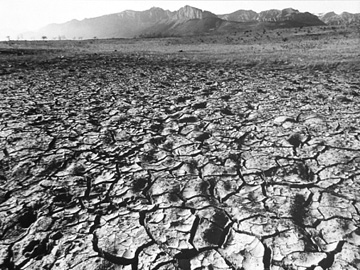Morley photographer kept difficulties in perspective
COFFEE WITH WARREN, with Warren Harbeck
Cochrane Eagle, February 21, 2007

This dramatic earthscape by Morley photographer/politician Gerald Kaquitts, who died Feb. 18, offers an important lesson in life. Photo by Gerald Kaquitts
A mentor of mine in the beauty of life died Feb. 18 of cancer. Gerald Kaquitts, of Morley, was 56.
Gerald was the son of Frank Kaquitts (Ganutha Îge, “Sitting Wind,” chief and artist) and Kathleen Kaquitts (Wîkoske Wathte, “Beautiful Maiden,” traditional Stoney Nakoda elder), both deceased. He and his wife, Rhonda, had five children and four grand-children.
In addition to being a fun-loving outdoorsman and golfer, Gerald was a historian and councillor for his Chiniki First Nation, and a staunch advocate for treaty and Aboriginal rights.
But it was as a photographer, philosopher and friend that he had his greatest impact on me.
An example of this impact is a photograph of his that he gave me back in the early 1980s – a framed image that hangs on the wall behind my computer and whispers to me every day to embrace life’s struggles from the right perspective.
At the time, so much of what was happening around me just made no sense. I felt like I was in a waterless wasteland. Gerald was sensitive to my needs and brought me the photograph to help me maintain my sanity.
The 16×20 inch black and white image is of a desolate summer scene near Gerald’s home not far from the entrance to Kananaskis Country. A dried, treacherously-cracked earthscape dominates the lower three fourths of the print. The fissures look enormous. Who could ever cross this hostile terrain? Yet, far off in the distance are the familiar mountains with slopes moist from melting snow nourishing the forest at their feet.
In reality, the seemingly unreachable mountains were almost at Gerald’s doorstep, and the parched wasteland was merely a dried mudhole only 20 or so feet across, easily traversed. Gerald had photographed the scene with an ultra-wide-angle lens from a point just a few inches above the “threatening” ground. Being so close to the mudflat magnified it to despairing proportions.
But, Gerald pointed out to me, if the scene could be viewed as an eagle sees it when soaring high, hope would return. For what is viewed from close up as insurmountable becomes but an insignificant speck in the grander scheme of things.
Looking at life from the right perspective can restore the beauty of the journey, Gerald was saying.
Well, for the last months of his life, Gerald had been very close to a difficult mudflat in his own journey. But now, like the eagle, he soars into greater understanding and peace.
Thank you, my friend, for being there for me in this nîbi ptenâ ne – in this all-too-short life. As Bette Midler put it so movingly in one of your favourite songs:
“I can fly higher than an eagle,
'cause you are the wind beneath my wings.”
© 2007 Warren Harbeck
JoinMe@coffeewithwarren.com